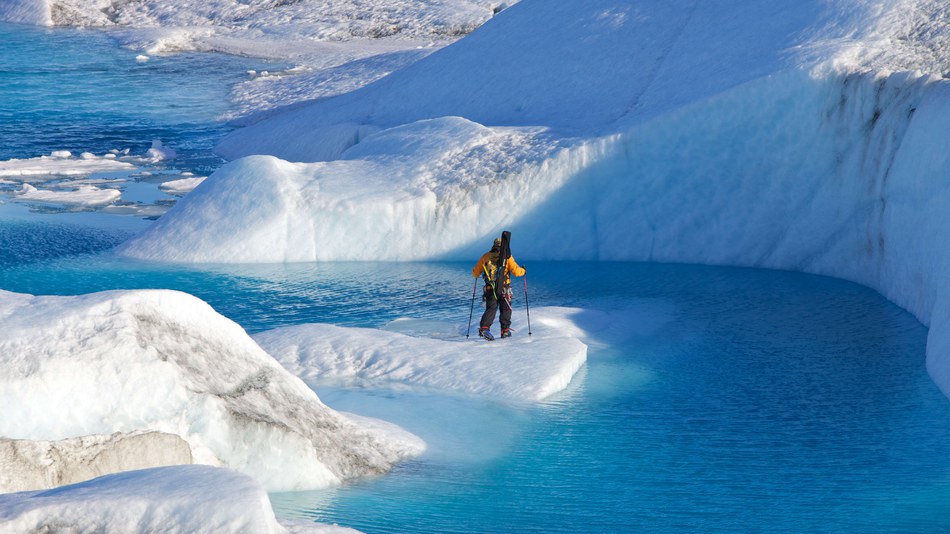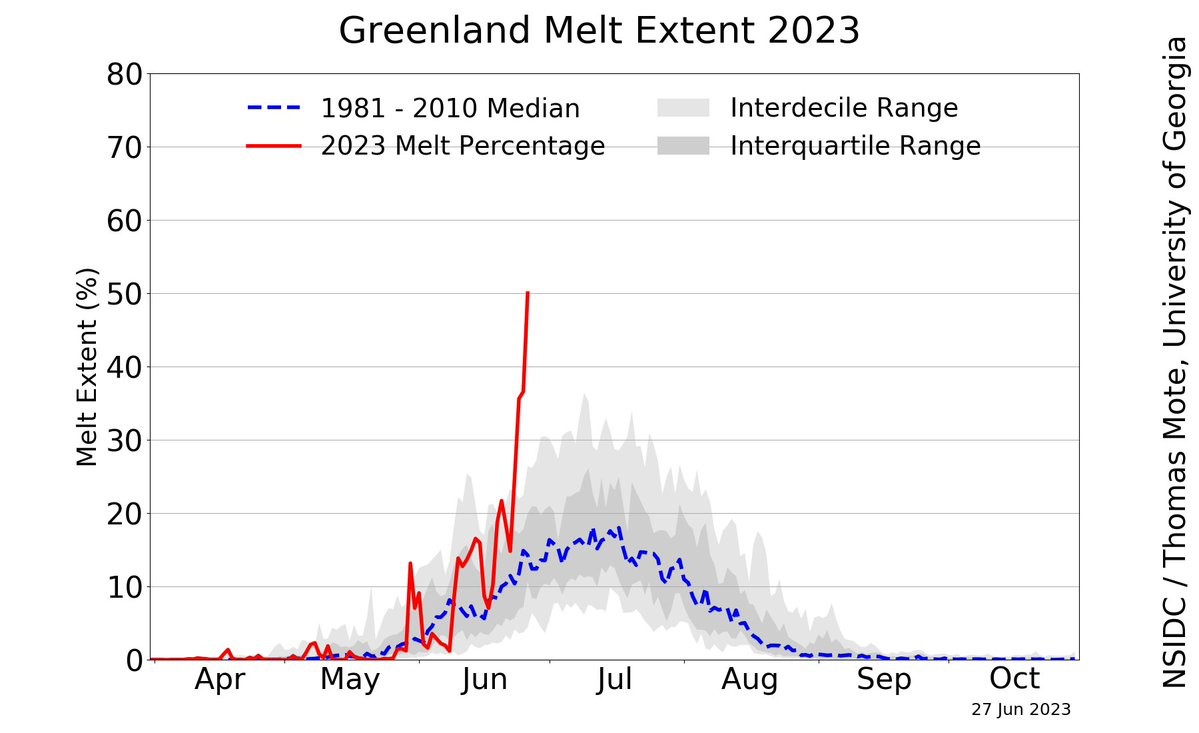
Will the world’s major coastal cities, such as NYC, survive escalating global heat conditions in Greenland? And what if both Greenland and Antarctica follow the recent very disturbing pattern of the world’s oceans? For the first time that scientists can recall, sea surface temperatures that always recede from annual peaks are failing to do so, staying high.
Climate change is getting dangerously worse, which is becoming a more common statement among scientists. Ecosystems are starting to fail right before our eyes. For example, in 2022 Europe experienced a big scare with temporary loss of full service for navigable commercial waterways, like the Rhine, and loss of potable water in regions of France and Italy, necessitating water delivery by truck to over 100 communities, with much of Asia experiencing similar issues, especially China and India.
Suddenly, the world is a different place, a description that fits Greenland, especially August 14, 2021, when it rained at Summit Station, 10,551 feet elevation. There’s no previous record of rainfall at the 2-mile summit. It was one more unprecedented climate event. More on Greenland and coastal cities follows herein.
According to the IPCC 6th Assessment Report: “There is high confidence that climate change has already caused irreversible losses in terrestrial, freshwater and coastal and open ocean marine ecosystems.” Climate scientists continue pumping out reports about those same irreversible losses, but frustration mounts as reports pile on top of reports in the face of negligible efforts by the 195 signatories to Paris ’15.
It’s not surprising that climate scientists are becoming street protestors.
Scientists Rebel
In December 2021 an offbeat science article called for scientists to stop feeding research into a bottomless pit of inaction: “The science-society contract is broken. The climate is changing… The tragedy of climate change science is that at the same time as compelling evidence is gathered, fresh warnings issued, and novel methodologies developed, indicators of adverse global change rise year upon year.” (Source: Bruce C. Glavoic, et al, The Tragedy of Climate Change Science, Climate and Development, Vol 14, Issue 9, 2022)
Furthermore: “We therefore call for a halt to further IPCC assessments. We call for a moratorium on climate change research until governments are willing to fulfil their responsibilities in good faith and urgently mobilize coordinated action from the local to global levels. This third option is the only effective way to arrest the tragedy of climate change science.” Ibid.
“Over 1,00o scientists from 25 countries staged protests last week following the release of IPCC’s new report.” (Source: Scientists Stage Worldwide Climate Change Protests After IPCC Report, Smithsonian Magazine, April 13, 2022).
At the American Geophysical Union meeting in December 2022, which is the largest annual meeting of scientists, activist scientists unfurled a banner that read: “Out of the lab & into the streets,” demanding rapid deep cuts to greenhouse gas emissions by 2025 to avoid catastrophic climate effects, meaning all hell will break loose. But maybe it’s already breaking loose? In fact, in many respects it is already breaking lose.
Greenland is starting to come apart at the seams right before our eyes, threatening to impact the world’s most prominent cities: New York City, Miami, Bangkok, Amsterdam, Ho Chi Minh City, Cardiff, New Orleans, Manila, London, and Shenzhen are the 10 most vulnerable cities for sea level rise. Based upon the following chart of Greenland melt extent, capturing only a short duration in time, the famous cities must hope this ominous graph, June 28, is nothing more than an aberration that dissipates soon. A nearly vertical spike of ice sheet melt extent can be seen on the chart from Jason Box, climatologist, Geological Survey of Denmark and Greenland.

Surely the radical spike up does not forecast new higher levels down the road, as it naturally dissipates, but what if it does not dissipate, similar to sea surface temperatures that always receded from annual peaks but failed to do so, staying high? Then, seawalls become mandatory.
“Sea surface temperatures (SST) have risen 5 degrees Celsius above normal during June. This is the warmest they have been in more than 170 years for this time of the year.” (Source: North Atlantic Marine Heatwave ‘Beyond Extreme’, Down to Earth, July 5, 2023)
Already, the combined ice mass loss for Greenland and Antarctica has been accelerating, fast and faster, from 116 billion tons per year in the late 1990s to 410 billion tons per year 2017–2020, which comprises the most recent data set. That’s a 250% increase in one decade, which is piping hot for a colossal block of ice. At that rate, it’s probably a good idea to start building seawalls; forget the plans, just build.
Meanwhile, the 10 coastal cities should keep their collective fingers crossed that the spike doesn’t portend the future, like the recent experience with ocean heat, which demonstrated major, maj0r unwelcomed changes in climate behavior. If so, the word “trouble” takes on new meaning for some of the world’s biggest cities. In fact, The Economist declared Greenland a “goner” a couple of years ago: The Greenland Ice Sheet Has Melted Past the Point of No Return, The Economist, April 25, 2020.
However, the problem runs deeper yet. A recent study of icesheets shows that the current generation of sea level rise modeling that’s commonly used by the Intergovernmental Panel on Climate Change (IPCC) and policymakers is too conservative, unintentionally lowballing, missing data that changes the complexion from a cautionary yellow to a red alert.
According to the study, the hidden interior of the Greenland ice sheet is destabilizing because of millions of hairline cracks that cause hydro-fracking that satellite observations and previous studies have not yet recognized. (Source: David M. Chandler, et al, Widespread Partial-Depth Hydrofractures in Ice Sheets Driven by Supraglacial Streams, Nature Geoscience, June 2023)
The implications of the Chandler study are profound as the hydrofractures occur far from crevasse fields and melt lakes where science ordinarily finds such occurrences. Over time tiny hairline cracks grow into giant gaping maws large enough to swallow a cathedral. Ice sheet stability is compromised.
Beyond the Chandler study, other recent studies reveal vulnerabilities that are not yet factored into sea level expectations by the IPCC or policymakers. For example: (1) warm ocean currents are flowing under ice shelves in Greenland and Antarctica, destabilizing and undercutting outlet glaciers (2) Abnormal levels of rainfall in Greenland, including regions where it’s never rained before, accelerate surface melt (3) foreign surface materials darken Greenland’s ice sheet and absorb more solar radiation, accelerating melt. And (4) Is Antarctica included in IPCC calculations for sea levels, or did they not have enough data points to include it? I think not. Meantime, the Antarctic Peninsula and West Antarctica are already teetering, like listing ships at sea. Nobody knows for sure how soon a crash happens, maybe Thwaites, the alleged Doomsday Glacier, hmm.
An international collaboration of 65 polar scientists established in 2011, named Ice Sheet Mass Balance Inter-Comparison Exercise (IMBIE) to reconcile measurements of ice sheet mass balance. It’s supported by the European Space Agency (ESA) and NASA. According to an April 20, 2023, press release: Since the early 1990s there has been a fivefold increase in melting of ice sheets. A five-fold increase is beyond disturbing, whatever that may be.
Underestimating sea level rise by the IPCC and policymakers is exposed in study-after-study. For example Eric Rignot, senior research scientist NASA Jet Propulsion Laboratory and professor, University of California, co-led a study of the Petermann Glacier, Greenland, which proved that the melt rate at the junction of the ocean with grounded ice is much more vigorous than expected. Their finding potentially doubles projections of sea level rise. (Source: Enrico Ciraci, Eric Rignot, et al, Melt Rates in the Kilometer-Size Grounding Zone of Petermann Glacier, Greenland, Before and During Retreat, Proceedings of the National Academy of Sciences, May 2, 2023)
Doubling sea level rise is difficult to fathom and would be nearly impossible to handle, especially with nobody planning for it to happen.
“These ice-ocean interactions make the glaciers more sensitive to ocean warming,’ said senior co-author Eric Rignot, UCI professor of Earth system science and NASA JPL research scientist. ‘These dynamics are not included in models, and if we were to include them, it would increase projections of sea level rise by up to 200 percent – not just for Petermann but for all glaciers ending in the ocean, which is most of northern Greenland and all of Antarctica,” Ibid.
Based upon numerous requests for a shorter-term forecast of likely sea level rise, an analysis was undertaken by NASA, the National Oceanic and Atmospheric Administration (NOAA), and the US Geological Survey, expecting significant sea level rise over the next 30 years, by region. They projected 10 to 14 inches (25 to 35 centimeters) of rise on average for the East Coast, 14 to 18 inches (35 to 45 centimeters) for the Gulf Coast, and 4 to 8 inches (10 to 20 centimeters) for the West Coast. (Source: NASA Study: Rising Sea Level Could Exceed Estimates for U.S. Coasts, NASA-Global Climate Change, November 1, 2022)
The wild card in NASA’s calculations is whether “the accelerating rate of sea level rise detected in satellite measurements from 1993 to 2020 – and the direction of those trends” used to determine future sea levels remains the same or accelerates beyond initial baseline calculations.
What can be done? The answers for what can be done are in the public domain. Indeed, what can be done is all about when, or if it will be done, which is the real issue.
“The greatest threat to our planet is the belief that someone else will save it.” (Robert Swan, one of the world’s greatest explorers, first to walk both the North and South Poles)
Robert Hunziker
Los Angeles
